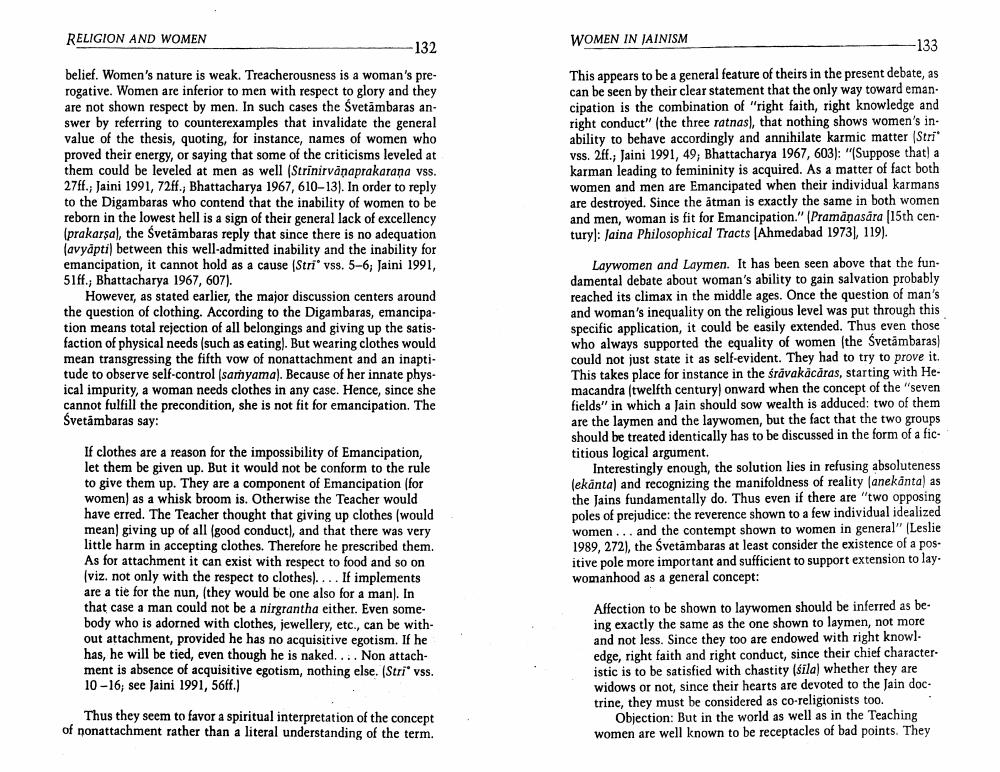Book Title: Women In Jainism Author(s): Nalini Balbir Publisher: Nalini Balbir View full book textPage 7
________________ RELIGION AND WOMEN WOMEN IN JAINISM --- 132 -133 This appears to be a general feature of theirs in the present debate, as can be seen by their clear statement that the only way toward eman. cipation is the combination of "right faith, right knowledge and right conduct" (the three ratnas), that nothing shows women's in. ability to behave accordingly and annihilate karmic matter (Stri vss. 2ff., Jaini 1991, 49, Bhattacharya 1967, 603): "(Suppose that) a karman leading to femininity is acquired. As a matter of fact both women and men are Emancipated when their individual karmans are destroyed. Since the atman is exactly the same in both women and men, woman is fit for Emancipation." (Pramanasara (15th centuryl: Jaina Philosophical Tracts (Ahmedabad 1973), 119). belief. Women's nature is weak. Treacherousness is a woman's prerogative. Women are inferior to men with respect to glory and they are not shown respect by men. In such cases the Svetambaras answer by referring to counterexamples that invalidate the general value of the thesis, quoting, for instance, names of women who proved their energy, or saying that some of the criticisms leveled at them could be leveled at men as well (Strinirvånaprakarana vss. 27ff.; Jaini 1991, 72ff., Bhattacharya 1967, 610-13). In order to reply to the Digambaras who contend that the inability of women to be reborn in the lowest hell is a sign of their general lack of excellency (prakarsal, the Svetämbaras reply that since there is no adequation (avyāpti) between this well-admitted inability and the inability for emancipation, it cannot hold as a cause (Strivss. 5-6; Jaini 1991, 51ff.; Bhattacharya 1967, 607). However, as stated earlier, the major discussion centers around the question of clothing. According to the Digambaras, emancipa. tion means total rejection of all belongings and giving up the satisfaction of physical needs (such as eating). But wearing clothes would mean transgressing the fifth vow of nonattachment and an inaptitude to observe self-control (samyama). Because of her innate physical impurity, a woman needs clothes in any case. Hence, since she cannot fulfill the precondition, she is not fit for emancipation. The Svetāmbaras say: Laywomen and Laymen. It has been seen above that the fun. damental debate about woman's ability to gain salvation probably reached its climax in the middle ages. Once the question of man's and woman's inequality on the religious level was put through this specific application, it could be easily extended. Thus even those who always supported the equality of women (the Svetämbaras) could not just state it as self-evident. They had to try to prove it. This takes place for instance in the śrävakācāras, starting with Hemacandra (twelfth century) onward when the concept of the "seven fields" in which a Jain should sow wealth is adduced: two of them are the laymen and the laywomen, but the fact that the two groups should be treated identically has to be discussed in the form of a fictitious logical argument. Interestingly enough, the solution lies in refusing absoluteness (ekänta) and recognizing the manifoldness of reality (anekanta) as the Jains fundamentally do. Thus even if there are two opposing poles of prejudice: the reverence shown to a few individual idealized women ... and the contempt shown to women in general" (Leslie 1989, 272), the Svetämbaras at least consider the existence of a pos. itive pole more important and sufficient to support extension to lay. womanhood as a general concept: If clothes are a reason for the impossibility of Emancipation, let them be given up. But it would not be conform to the rule to give them up. They are a component of Emancipation (for women) as a whisk broom is. Otherwise the Teacher would have erred. The Teacher thought that giving up clothes would mean, giving up of all good conduct), and that there was very little harm in accepting clothes. Therefore he prescribed them. As for attachment it can exist with respect to food and so on (viz. not only with the respect to clothes). ... If implements are a tie for the nun, (they would be one also for a man). In that case a man could not be a nirgrantha either. Even some. body who is adorned with clothes, jewellery, etc., can be with out attachment, provided he has no acquisitive egotism. If he has, he will be tied, even though he is naked. ... Non attachment is absence of acquisitive egotism, nothing else. (Strivss. 10 -16; see Jaini 1991, 56ff.) Affection to be shown to laywomen should be inferred as be. ing exactly the same as the one shown to laymen, not more and not less. Since they too are endowed with right knowl. edge, right faith and right conduct, since their chief character istic is to be satisfied with chastity (sila) whether they are widows or not, since their hearts are devoted to the Jain doctrine, they must be considered as co-religionists too. Objection: But in the world as well as in the Teaching women are well known to be receptacles of bad points. They Thus they seem to favor a spiritual interpretation of the concept of nonattachment rather than a literal understanding of the term.Page Navigation
1 ... 5 6 7 8 9 10 11 12
